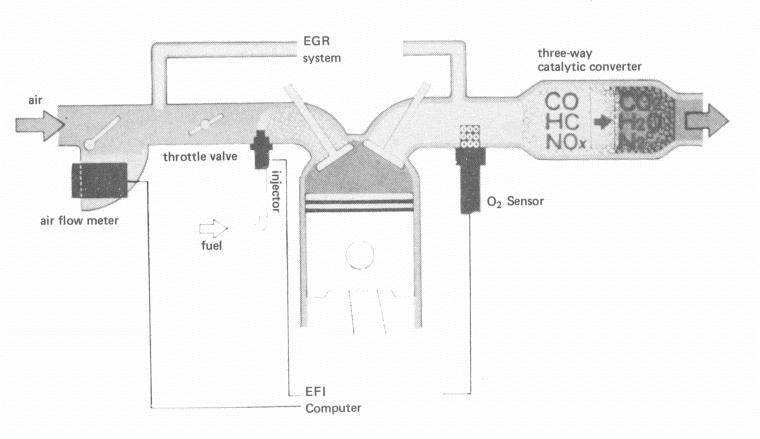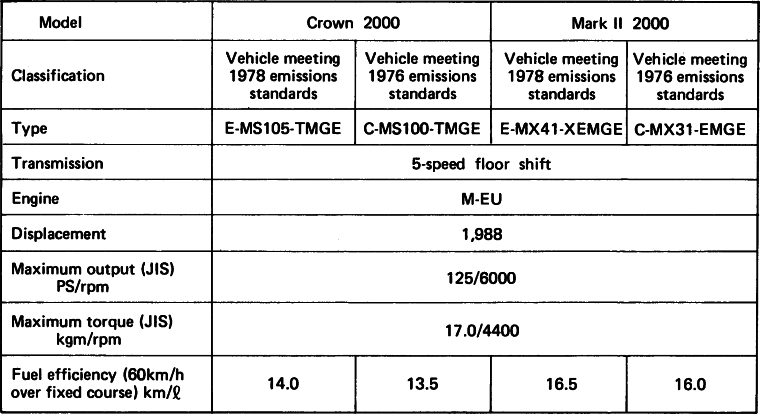Jun. 24, 1977
TOYOTA INTRODUCES THE CHASER,
ANEW HIGH-GRADE PERSONAL CAR
12 Variations of Chaser, 27 Variations of Crown 2000 and 17 Variations of
Mark II 2000 Meet 1978 Emissions Standards with Unique 3-Way Catalyst System
TOKYO―Toyota Motor Co., Ltd., and Toyota Motor Sales Co., Ltd., put on nationwide sale today through its Toyota Auto Dealers 40 variations of the Chaser, a new high-grade sub-compact, including 12 variations which meet Japan's 1978 emissions standards. Twenty variations are 4-door sedans, and twenty are 2-door hardtops. The Chaser is for the domestic market only.
Also put on sale today are 27 variations of the Crown 2000 and 17 variations of the Mark II 2000, all mounted with an M-EU engine (6-cylinder, 2000cc, with electronic fuel injection). The 12 variations of the Chaser (6 sedans, and 6 hardtops) which meet the 1978 emission standards are mounted with the same ME-U engine, which utilizes a unique three-way catalyst system developed by Toyota for meeting the standards.
The three-way catalyst system developed by Toyota cleanses CO, HC and NOx emissions simultaneously through the combination of a three-way catalytic converter, an air-fuel mixture compensator, an exhaust gas recirculation (EGR) system and other emissions cleansing devices.
By its nature, the three-way catalyst cleanses simultaneously the CO, HC and NOx in exhaust emissions when the air-fuel mixture is very close to the theoretical point which gives perfect combustion. In order to make maximal use of the characteristics of the three-way catalyst, an air-fuel mixture compensator is utilized for controlling the mixture under various driving conditions and keeping it as close as possible to the theoretical point which gives perfect combustion.
Since the three-way catalyst system allows combustion very near the theoretically perfect air-fuel mixture, it gives good fuel efficiency, driving performance and emissions cleansing, it is also durable and highly reliable.
Toyota developed the Chaser in order to meet the diversified demand which has emerged in the high-grade personal car market, particularly the increased demand for personalized luxury cars. The Chaser is a high-grade personal car that is high in quality and rich in individualized characteristics.
In its development, Toyota engineers placed emphasis not only on safety and on emissions control capabilities but also on weight reduction, effective interchangeability of parts with vehicles already in production, high fuel efficiency and other points for conserving raw materials and natural resources. At the same time, great efforts were made to improve drivability, comfort, handling and other characteristics so important to any automobile.
The Chaser is available in two body types―a 4-door sedan and a 2-door hardtop―and in six grades, ranging from deluxe to SG touring. It has four engine types: a 3T-U type (4-cylinder, 1770cc); an 18R-U type (4-cylinder: 1980cc), an M-U type (6-cylinder, 1988cc); and an M-EU type (6-cylinder, 1988cc, with EFI). Three types of transmissions are used: a 4-speed floor shift; a 5-speed floor shift; and a 3-speed automatic shift. The combination of the body types, grades, engines and transmissions makes a total of 40 variations available in the Chaser series―twenty sedans, and twenty hardtops.
- The main features of the Chaser are as follows
-
- Style.
The body styling is basically simple, bright and richly individualistic. A good field of vision has been assured and all-around safety is outstanding. The front grill is bold and solid. The interior is a study in composure and has a high level of luxury. - Comfort & handling.
Toyota designers paid particular attention to providing a roomy interior and trunk space, and ideally located levers and switches; a 3-joint propeller shaft is used in all variations for less noise and vibrations; careful overall attention was paid to keeping noise and vibrations low in order to make the interior as quiet and pleasant as possible; the SG Touring version has a tilt steering wheel as an option which allows the driver to adjust the steering wheel angle to fit his body size and posture. - Emissions control.
The versions mounted with the M-EU engine have passed Japan's 1978 emissions standards through use of a three-way catalyst system developed by Toyota. The versions mounted with the 3T-U, 18R-U and M-U engines have passed the 1976 standards through use of Toyota's catalyst system. - Safety.
A braking device has been utilized which allows stable braking even with a light depressing of the brake pedal; the body style provides good field of vision; a dual-roll type emergency locking retractor is used with the seat belts, and an OK monitor accident prevention panel is used. - Suspension.
All front wheels use MacPherson strut independent suspensions; rear wheels use 4-link suspensions or semi-trailing arm independent suspensions. - Conservation of materials and resources.
Rationalized design of all parts, including the body structure, have resulted in lighter weight; those efforts contributed to raising the fuel efficiency; greater standardization of parts with existing models was also achieved.
- Style.
Details regarding the three-way catalyst system are attached. Also attached are emissions and fuel consumption data on the Crown, Mark II and Chaser, and performance data on the Crown and Mark II.
Three-Way Catalyst System
The unique three-way catalyst system Toyota has developed combines a three-way catalytic converter, an air-fuel mixture compensator, an EGR (Exhaust Gas Recirculator) and other emissions cleansing devices. It is a superior emissions cleansing system that makes maximal use of the special characteristics of the reciprocal engine.
Three-way Catalyst System
in M-EU Engine

EXPLANATION OF SYSTEM COMPONENTS
- Three-way catalytic converter.
This converter oxidizes the CO and HC in the engine's emissions and deoxidizes NOx to turn it into CO2, H2O and N2.

- Closed-loop air-fuel mixture system.
In order to obtain high cleansing capabilities for the three-way catalyst, it is necessary to control the air-fuel mixture and keep it close to the mixture that theoretically gives perfect combustion. A closed-loop air-fuel mixture system performs that function. It is comprised of an O2 sensor and an EFI (electronic fuel injection) device. This system detects the concentration of oxygen in the exhaust gases and computes the appropriate amount of fuel to be injected in order to control the air-fuel mixture and keep it near the theoretical mixture for perfect combustion. It has a feedback function for carrying out any needed adjustments in the air-fuel mixture.

- O2 sensor.
The O2 sensor is basically a zirconia element given a test tube shape, coated lightly on the inside and outside with platinum and given an electrode function. It is attached to the exhaust manifold. Its outside surface is in direct contact with the exhaust gases while its inside surface is in direct contact with the free air. The O2 sensor first of all detects the concentration of oxygen in the exhaust gases. Depending on the difference between that concentration and the concentration of oxygen in the free air, an electric charge is generated. The generated voltage passes from the platinum electrode to the EFI computer. - EFI.
A computer in the EFI measures the voltage transmitted from the O2 sensor. It compares that voltage with a voltage value it has previously been programmed with. The difference in the two values allows the computer to determine whether the air-fuel mixture is too lean, say, or too rich, in terms of the mixture that theoretically will give perfect combustion. The computer computes the appropriate amount of fuel needed for maintaining a mixture near the theoretically ideal point. It then performs any necessary adjustments and thus controls the air-fuel mixture closely in order to keep it near that point. - EGR.
Samples of the exhaust gases are taken from the exhaust manifold and, depending on the particular engine conditions, an appropriate volume of those gases is recirculated from the intake system to the air-fuel mixture. The generation of NOx is prevented by lowering the maximum combustion temperature in the cylinder.








